'One Hit Wonders'
When the first hand-held calculators appeared in the early 1970s they were very expensive and many companies saw the opportunity of making a profit by manufacturing them. Some of these companies are familiar to us since they are still producing calculators today, having introduced dozens of models and sold millions of calculators over the years.
Other companies manufactured a number of models over several years but were eventually hit by the plummeting price of calculators in the mid to late 1970s and departed the calculator business.
A third, and very interesting, category are those companies that saw the opportunity of electronic calculators in the early 1970s and manufactured just one or two models, but for one reason or other, mainly economic, never produced any more. These are the 'One Hit Wonder' companies.
In March 1972 the journal Electronics reported[1]:
"New calculator firms favored. Larger firms handicapped.
It is apparent that more startup companies or smaller firms are finding it easier than the larger business machine companies to move up fast with new technologies. Indeed, the simple $99 calculator seems to be the
divider between the upstart low-overhead technology opportunists and established firms in the electromechanical business machine market. Some of the latter will participate in the low-price market only with imported
machines.
But as fewer parts are required for calculators, there's less reason to assemble them overseas. The bigger companies counting on imported machines to win them a piece of the consumer market may
be deluding themselves as U.S. competition heats up."
However, the opportunity for small companies to make a profit by manufacturing simple four-function calculators in small quantities soon passed as large companies entered large-scale production.
Often these, what could be called 'One Hit Wonders', were small companies and little or nothing is now known about them, but their calculators occasionally turn up. Many were American companies, but there were one or two others elsewhere.
Later, small marketing companies bought calculators labelled for them from other manufacturers (termed the original equipment manufacturers, or OEMs), usually in Asia, but these calculators are usually not so interesting. Particularly in this category are the "Standard type 1" and the "Standard type 2" calculators which are found with the names of many companies on them.
Below is a sample of these 'One Hit Wonder' calculators:
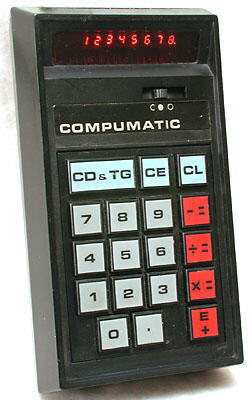
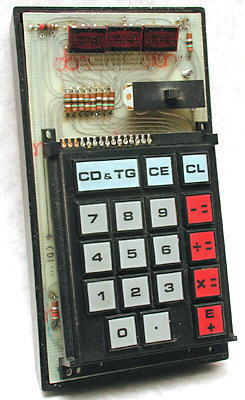
Compumatic 8A
Display is 8 digits, red LED.
Power supply is 5x AA rechargeable batteries.
4-functions, using RPN (Reverse Polish Notation).
The key marked "CD & TG" is a dummy key and does not appear to have any function, but why is it marked so ?
The main integrated circuit is a National Semiconductor MM5725N, here date coded to the end of 1972.
Size 82 x 146 x 39 mm / 3.2" x 5.75" x 1.5".
c1972.
Made in U.S.A.
Compumatic
P.O. Box 3263, Huntsville, Alabama 35810.
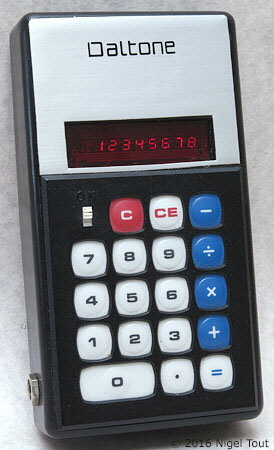
Daltone Pocket 8
Display is 8 digits, red LED.
Power supply is 1x PP3 9v battery.
4-functions.
Size 65 x 117 x 27 mm / 2.6" x 4.6" x 1.1".
Made in U.S.A.
Dalamal Electronics Corp.
107 Franklin Street / New York, N.Y. 10013.
Notes:
- The calculator does not have a model number on it but the box has Daltone Pocket 8.
- The membrane keys are difficult to use since they are recessed with small openings which makes it difficult for a finger to press them properly.
- "The Complete Collector's Guide to Pocket Calculators" says "Daltone made several calculator kits for consumer construction" and lists the two models shown below:
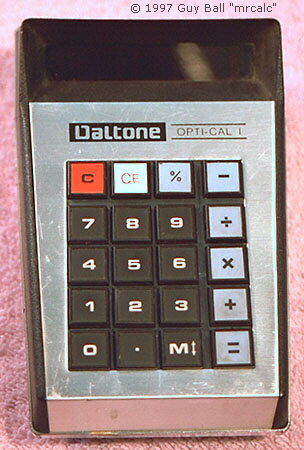
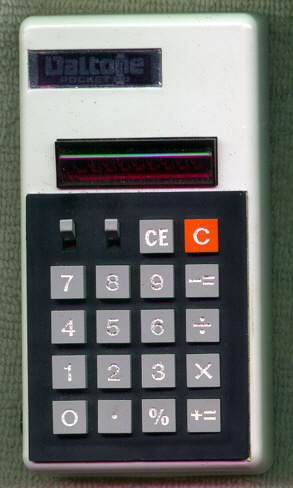
Daltone Opti-Cal 1
4-function, %, memory.
8 digits, VFD.
Daltone Pocket 80
4-function.
8 digits, red LED.
Sold as kit.
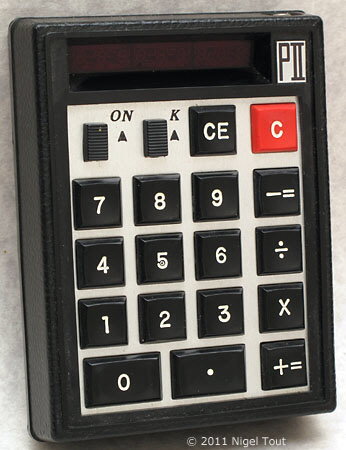
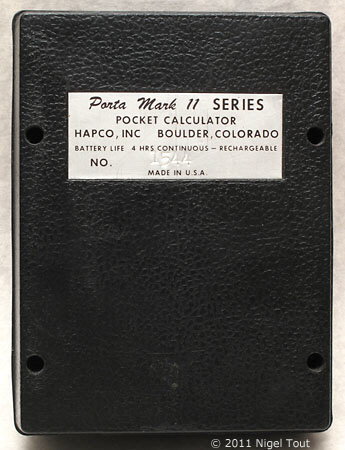
Hapco Porta Mark II
Display is 8 digits, red LED.
Power supply is 6x large, rechargeable, button cells.
4-functions, using using "Klixon" keypad.
Size 76x102x31mm / 3.0x4.0x1.25".
Made in U.S.A.
Hapco Inc., Boulder, Colarado.
This is a small but chunky calculator similar to the Titan RBM and uses the same unusual type of rechargeable button cells, as seen below.
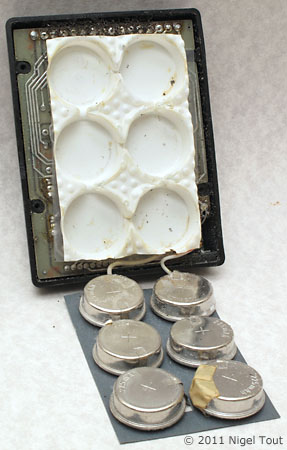
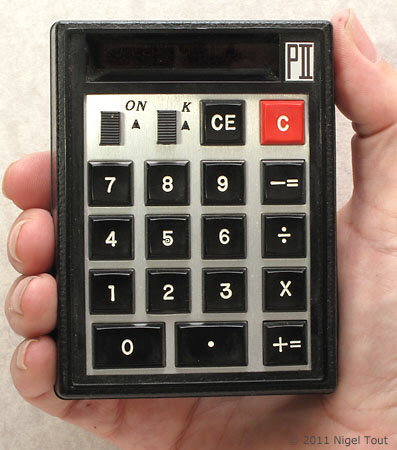
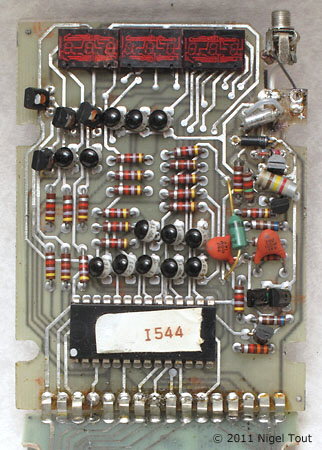
The circuit board, with the integrated circuit at the bottom and the LED display at the top. The black items are individual transistors and the striped items are resistors.
Mini & Mini A
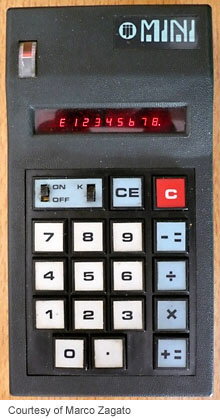
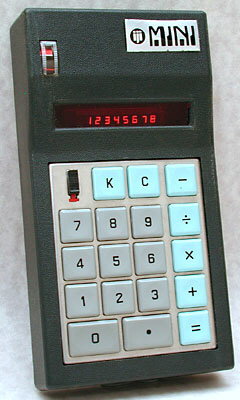
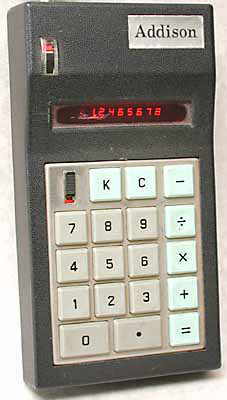
Iain Jones International Mini
Iain Jones International Mini A
Addison Mini A
Iain Jones International Mini, Mini A and Addison Mini A
Display is 8 digits, red LED.
4-functions.
9v (PP3) rechargeable, see photograph of the rear, above.
Has a battery-level meter, just above the left end of the display.
Main integrated circuit of the Iain Jones International Mini A is a General Instrument C500, here date coded mid 1972.
Main integrated circuit of the Addison Mini A is a General Instrument C550, here date coded early 1973.
80 x 149 x 28 mm (3.1" x 5.9" x 1.1").
c1972.
The label on the back of the Mini says "Made in USA by Iain Jones International, LTD, Great Neck NY, U.S.A."
The label on the back of the Mini A says "Designed and manufactured by Iain Jones International, Ltd, Atlanta, Georgia,
U.S.A."
We have no information about the name Addison.
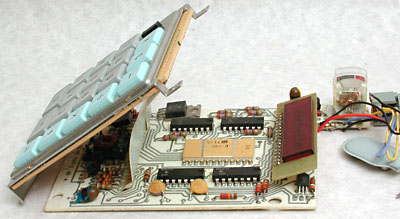
With the casing removed, showing the Texas Instruments "Klixon" keypad, and the circuit board with the gold coloured GI C500 integrated circuit, which was a very common calculator integrated
circuit at this time.
To the right of the LED display is the battery-level meter.
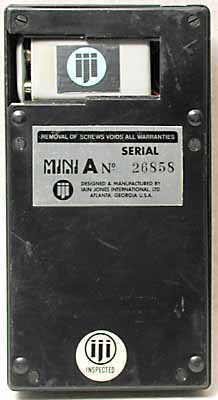
The rear of the Addison shows Iain Jones International labelling.
Phoenix 101
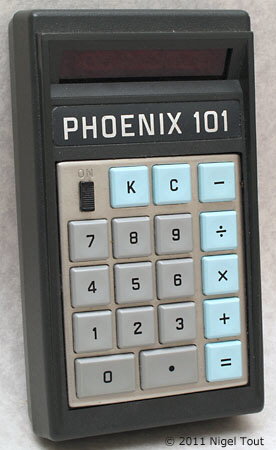
Iain Jones International Phoenix 101
Display is 8 digits, red LED.
4-functions.
4x AA rechargeable batteries.
The integrated circuits are date-coded late 1972 to early 1973.
80 x 149 x 28 mm (3.1" x 5.9" x 1.1").
c1973.
Made in U.S.A.
There is no company name on the calculator but the circuit board is labelled "IJI" (Iain Jones International).
Phoenix/B
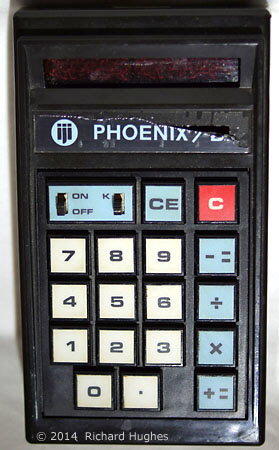
Iain Jones International Phoenix/B
Display is 8 digits, red LED.
4-functions.
6x AA rechargeable batteries.
Iain Jones International, Great Neck, NY, U.S.A.
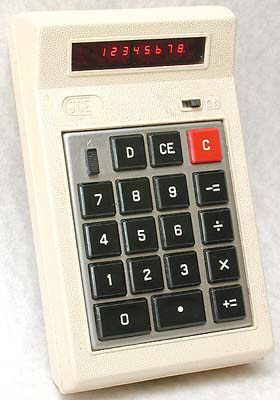
JCE Mark II
Display is 8 digits, red LED.
Power supply is 5x AA batteries.
4 functions.
Main integrated circuit is Texas Instrument TMS0103, here date coded early 1973.
82 x 139 x 42 mm / 3.25" x 5.5" x 1.7".
John Colling Enterprises, Palo Alto, California, U.S.A.
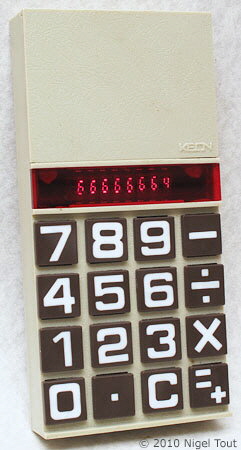
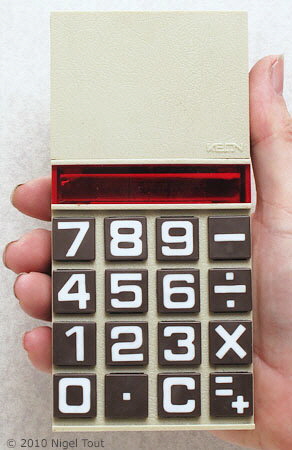
Keon KE-003A
Display is 8 digits, red LED.
Power supply is 4x AA batteries.
4 functions.
76 x 161 x 22 mm / 3.0" x 6.3" x 0.9".
Made in Hong Kong
Keon, London, Hong Kong, Melbourne.
Most of the "One-hit-wonders" on this page were designed and manufactured in the U.S.A. This is to be expected since the U.S.A. was where the technology of the integrated circuits and LED displays
was being developed and so these, and the information of how to use them, were readily available to local companies.
Keon calculators are an exception since these very distinctive models with the extra-large buttons were
designed in Australia. For more information see the separate article about the development of Keon calculators "Keon Calculators from Australia".
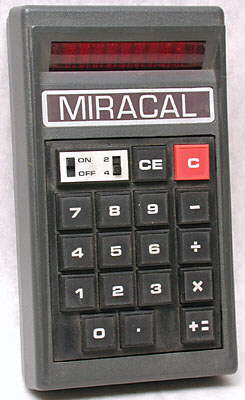
Miracal
Display is 8 digits, red LED.
Power supply is 4x AA rechargeable batteries.
4 functions.
Main integrated circuit is CT5002, here date coded early 1973.
78 x 137 x 37 mm / 3.1" x 5.4" x 1.5".
P D Labs, 2120 Ronald St., Santa Clara, California, U.S.A.
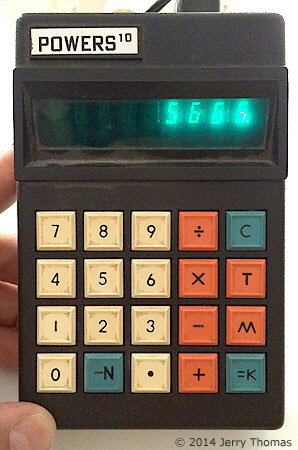
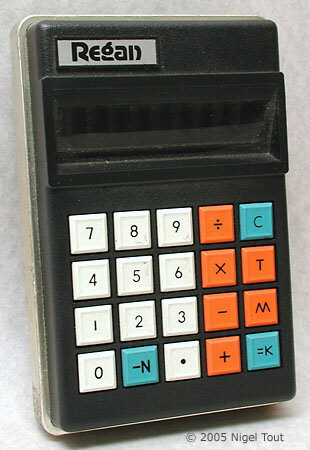
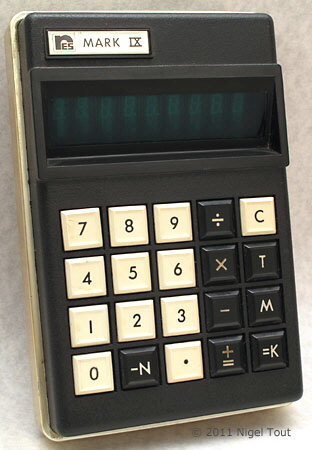
POWERS10, Regan RA900P, & RES MARK IX
Three calculators which appear to be very similar apart from the name badge.
Display is 8 digits, individual tubes.
Sealed power supply.
4 functions, memory.
94 x 143 x 46 mm / 3.7" x 5.6" x 1.8".
Electronics journal of June 5 1972 states[2]: "The latest American firm to jump into the calculator fray is Radient Energy Systems of Newbury Park,
Calif., which will make two different machines for Logic Data, a Chicago firm ... Radient's models, one a desk model and the other a small portable, are expected to sell for about $100.
Size of the Logic Data deal is
not known, but Radient has given a contract to Western Digital Corp., which will supply the two silicon-gate MOS chips in the machines for $4 million. The calculators will use low-voltage gas display tubes from ISE electronics
of Japan."
Of these three models the more common are the Regan RA900P and the RES MARK IX.
The Regan model has a label on the back stating "Regan Industries, Glendale, California, U.S.A."
The RES MARK IX model has a label on the back stating "Radiant Energy Systems, Newbury Park, California, U.S.A."
Gary Johnson, who was the quality control manager for the calculators at Regan Industries, has been in touch and has kindly supplied the following information:
- Regan Industries was mainly a office supply company.
- The calculator was manufactured by a company headquartered in Thousand Oaks, CA, called Powers of Ten LTD.
- This was the first handheld calculator with a memory for under $100.00.
Jerry Thomas kindly sent the photograph of his similar calculator which has the badge "POWERS10" and on the back has "Powers of Ten, Woodland Hills, CA".
Similar models include: beda GT.
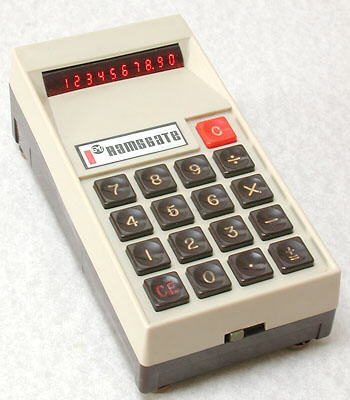
Ramsgate M-11
Display is 10 digits, red LED.
4-functions. Fixed decimal point, at 0, 2, or 4 places of decimals.
6v (4-AA batteries).
Integrated circuit is a Mostek MK5010P, here date coded late 1972.
76 x 147 x 31 mm. (3.0" x 5.75" x 1.25").
c1972.
Manufactured by Ramsgate Inc., Eveleth, Minnesota, U.S.A.
The Ramsgate M-11 is chunky, with a slight wedge shape, and very solidly made.
It was the only calculator model made by Ramsgate Inc., a company that specialised in making printed circuit boards. In 1972, seeing the consumer demand for pocket calculators, the company decided to develop its own model using the Mostek MK5010P early "calculator-on-a-chip". The resulting M-11 calculators were supplied to a major department store in Los Angeles, then one of the biggest calculator markets. An advertisement for the M-11 in the Los
Angeles Times of December 19th, 1972 described it as a "family calculator" and "budget-priced" for $89.95.
With a second model under development, Ramsgate Inc. was forced to close when one of its customers, an electronics company in New York, filed for bankruptcy while owing Ramsgate several hundred thousand dollars[1].
Reference:
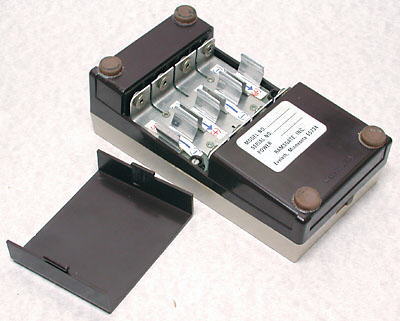
The photograph above shows the battery holder of the M-11, which is one of most robustly made of any in a hand-held calculator and puts most others to shame.
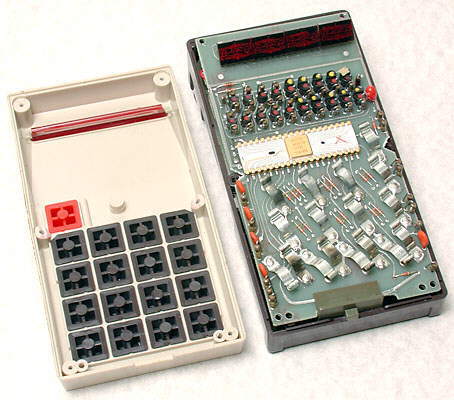
The case has been opened to reveal the circuit board with the Mostek MK5010P early "calculator-on-a-chip" and the very unusual keyboard. The contacts are just bent strips of metal which are pressed by the keypads onto stud contacts set in the circuit board. This example is very prone to contact bounce causing multiple numbers to be displayed from one key press - this is probably made worse by tarnishing over the years.
RBM calculators are a bit of a puzzle. Shown here is one model only marked 'RBM' with an advertisement for it from 'Titan RBM of Havre, Montana, U.S.A', and another model from 'RBM Corporation, Arlington, Texas, U.S.A.'
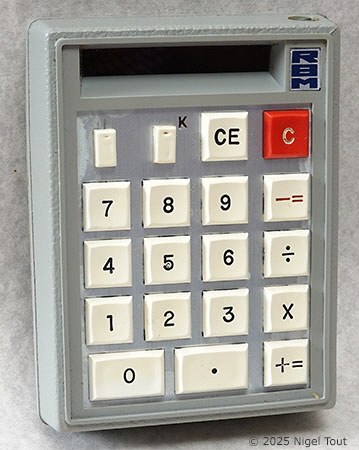
Titan RBM
Display is 8 digits, red LED.
Power supply is 6x large, rechargeable, button cells.
4-functions, using using "Klixon"-type keypad.
Size 76x102x31mm / 3.0x4.0x1.25".
According to the advertisement below it is from Titan RBM and made in the U.S.A.
This is a small but chunky calculator similar to the Hapco Porta Mark II and uses the same unusual type of rechargeable button cells, as seen below.
Unfortunately, although there is a cutout for a label on the rear of the case there is no label in place.
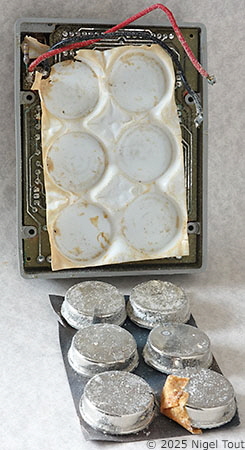
The unusual rechargeable button cells.
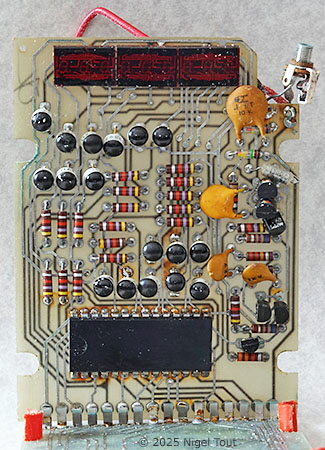
The circuit board, with the integrated circuit at the bottom (with markings removed) and the LED display at the top. The black items are individual transistors and the striped items are resistors.
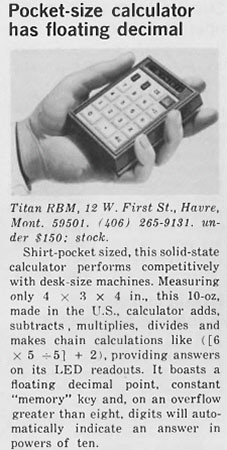
Advertisement for this calculator from June 1972.
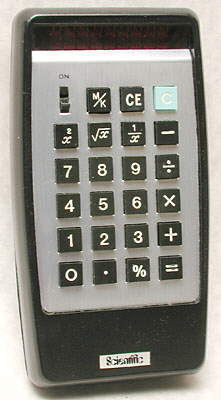
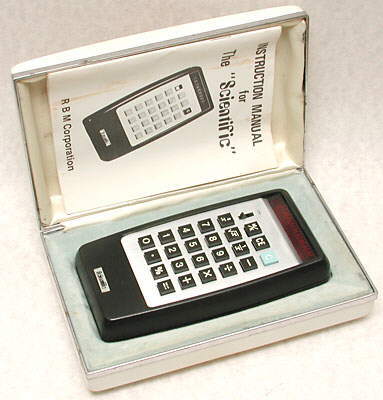
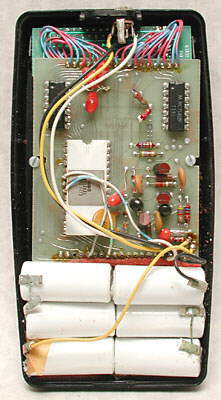
RBM Scientific
Display is 8 digits, red LED.
Power supply is 6x rechargeable cells.
4 functions, %, square root, square, reciprocal.
77 x 142 x 31 mm / 3.0" x 5.6" x 1.2".
The main integrated circuit is a MOS MCS2523, here date coded late 1973.
RBM Corporation, Arlington, Texas, U.S.A.
This is quite a stylish calculator and comes in a presentation case so was probably expensive.
This calculator is similar to the Columbia Scientific, but which company manufactured it is not known. If you have any information please get in touch.
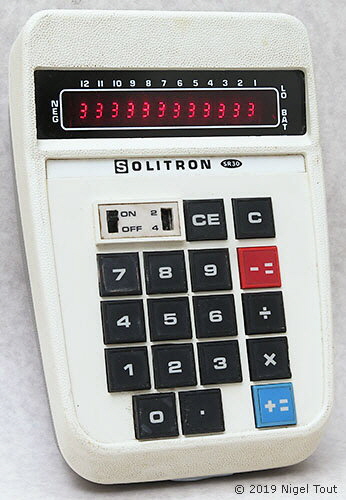
Solitron SR30
Display is 12 digits, red LED.
Fixed decimal point with 2 or 4 decimal places.
Power supply is 9v, either replaceable PP3 battery or apparently a rechargeable battery pack (probably using 6x rechargeable cells).
4 functions.
99 x 147 x 55 mm / 3.9" x 5.8" x 2.2".
The main integrated circuit is a Cal-Tex Semiconductor Inc. CT5002, here date coded early 1973.
The keyboard is made by Wild Rover Corp.
Serial No. 01140.
Solitron Devices Inc., West Palm Beach, Florida, U.S.A.
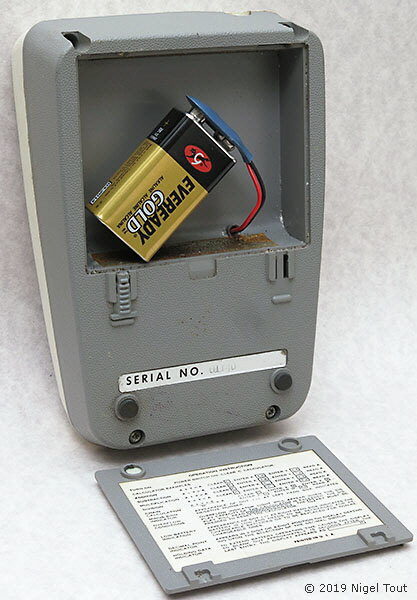
The rear of the calculator with the battery cover removed shows a battery compartment with a typical 9v battery connector. Although a PP3 battery can be inserted properly there is much more room than required and it appears that a rechargeable battery pack could alternatively be fitted.
This is confirmed by the instruction printed on the battery cover reading: "Appearance of a dot (.) at right hand side indicates the battery is low and needs to be recharged for rechargeable batteries or to be replaced for non-rechargeable ones".
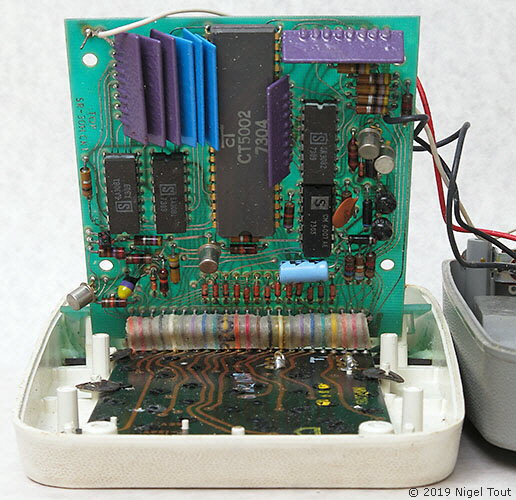
The main circuit board of the calculator with the large Cal-Tex Semiconductor Inc. CT5002 calculator integrated circuit, here date coded early 1973, prominent in the middle.
There are four smaller integrated circuits, two SA3081 and one SA3082 (which are likely to be display drivers), and one CM 4007 AE (which appears to be a CMOS inverter array). These all carry the large 'S' logo indicating manufacture by Solitron Devices and early 1973 date codes.
There are also four transistors in metal cans and two in black plastic encapsulation.
The blue and mauve rectangular devices are likely to be resistor arrays.
The journal 'Electronics' reported in October 1972[3]:
"Solitron joins calculator club
The latest MOS
producer to jump on the calculator bandwagon is Solitron Devices in San Diego. But for Solitron, the move isn't quite as unexpected as it was for NRMEC and TI because the company already makes such end-user automotive
products as ignition systems. What's more, the firm is buying the MOS, rather than making it. "Why should I reinvent the wheel when I can get the chips at current prices?" says Kenneth Seybold, vice president and
division manager.
Solitron has five models in the works, including the only 12-digit pocket-size unit on the market, expected to sell for about $150: an eight-digit pocket calculator, and three desktop
models—one with memory using two Mostek chips. The other four calculators use Cal-Tex chips."
Incorporated in 1959, Solitron Devices Inc. now specialises in manufacturing power semiconductors and systems. In the past the company also manufactured a variety of semiconductor components including a calculator chip-set, as used in the Olympia CD200.
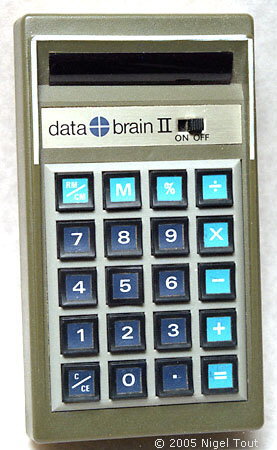
Unifive Industries Corporation data brain II (aka Unifive 301)
Display is 8 digits, red LED.
9v (6x AA rechargeable cells).
4 functions, %, memory.
94 x 143 x 46 mm / 3.7" x 5.6" x 1.8".
Manufactured in U.S.A. by
Unifive Industries Corporation
Marietta, Georgia 30060.
"Made especially for World Book Encyclopedia"
$59.95 in 1974.
Note that this model is similar to the Calfax data brain II, which uses a 9V (PP3) replaceable battery and was made in Hong Kong.
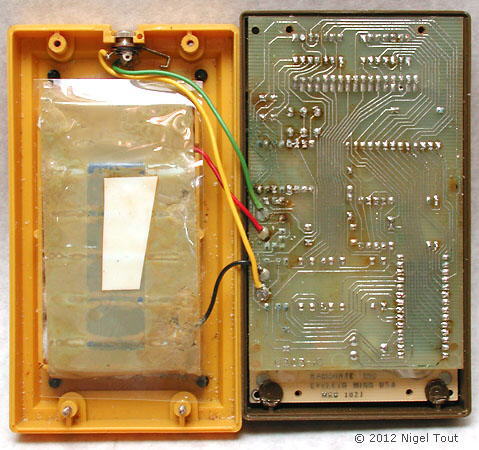
Inside with the rechargeable cells on the left and the circuit board on the right.
Further "One Hit Wonder" companies, which manufactured just one or two models include:
- Apollo: Des Plaines, Illinois, U.S.A.
- Aries: Peabody, Massachusetts, U.S.A.
- Bashaw: Bashaw Industries, Fairfield, New Jersy, U.S.A.
- PRA: Price Research Associates, U.S.A.
- RMS International: Westlake Village, California, U.S.A.
Reference:
Vintage Calculators
Text & photographs copyright, except where stated otherwise, © Nigel Tout 2000-2026.